Table of contents
What is Galanga? What is Galangal? Raw Thai ginger, also known as Greater Galangal ( Alpinia galanga (L.) Willd.), is a popular and almost indispensable spice in Thai cuisine. Greater Galangal should not be confused with the related True Galangal or with ginger. Thai ginger can be eaten raw. It is rarely available in organic quality.
Use in the kitchen
What does galangal taste like? The aroma of fresh galangal is reminiscent of pine needles and has subtle bitter, sharp and lemony components. When dried, Thai ginger has a sweet and cinnamon-like smell. Essential oils and resins (galganol, alpinol) are responsible for its taste. The different taste characteristics of fresh and dried Thai ginger can be explained by the different oil composition. Thai ginger only vaguely resembles ginger in terms of taste.
The yellowish, woody rhizome with the pink side shoots and the young stems of Thai ginger are mainly used. The edible and aromatic leaves of the greater galangal can also be used and the seeds serve as a cardamom substitute.
Thai ginger is used as a spice. In Arabic and Southeast Asian cuisine, it enriches many typical Indonesian and Thai dishes. In Thailand, the rhizome is usually used raw, as it has a completely different taste when dried.
Sometimes greater galangal is an additional ingredient in the Chinese five-spice powder, which contains cloves, star anise, fennel seeds, Sichuan pepper and cassia cinnamon. While Thai ginger was very popular in Western countries in the Middle Ages, it is now rarely used in European cuisine.
Before use, peel the raw rhizome (colloquially tuber, root) and chop it up. Due to its woody consistency, Thai ginger (Siamese ginger) is only used as a flavoring in some dishes. Grated, its high fiber content is hardly noticeable and can be eaten without any problem. Cut into thin slices, finely chopped or grated, Thai ginger is used as a spice in curries, soups, salads, in woks, for rice dishes, fried foods, exotic drinks, smoothies or teas. Finely grated, pureed or ground, the rhizome is the main ingredient in Thai red and green curry pastes.
Thai ginger goes well with potatoes, pumpkin or coconut milk. Like its relative ginger ( Zingiber officinale), greater galangal also goes well with garlic.
Galanga spice, which is usually available dried and in slices in Europe, can be placed in warm water before use. This reduces the spiciness and makes it more similar to the taste of fresh products.
Extracts from the rhizome are used to flavor bitters, liqueurs such as Chartreuse, low-alcohol beverages and gingerbread.
What is the difference between galangal and ginger? Thai ginger Difference to ginger: Alpinia galanga is a ginger-like spice and a medicinal plant. The two related plants are ginger plants, but belong to different genera. In the kitchen, the rhizomes can be used in a similar way. The ingredients and flavors differ from each other. Overall, Thai ginger is a little milder.
Vegan recipe for vegetable curry with Thai ginger
Ingredients: 4 tbsp rapeseed oil ; 3 tbsp green curry paste; 2 garlic cloves, finely diced; 1 tbsp coconut blossom sugar ; 10 kaffir lime leaves (Asian shop); 2 carrots, thinly sliced; 1 small eggplant, diced; 300 g Hokkaido pumpkin, diced; 1 chili, scored; 40 g Thai ginger (alternatively: galangal), peeled and sliced; 3 stalks lemongrass, in pieces; 350 ml vegetable stock ; 400 ml coconut milk; 100 g mushrooms, quartered; 6 spring onions, in pieces; 10 cherry tomatoes, halved; 50 g cashews (or healthier: macadamia nuts), chopped (possibly roasted); 4 tablespoons lime juice and 10 sprigs coriander, chopped.
Preparation: First, heat the rapeseed oil and sauté the curry paste and garlic in it. Then add the sugar, kaffir lime leaves, carrots, aubergine, pumpkin, chilli, galangal ginger ( Alpinia galanga) and lemongrass and sauté all the ingredients briefly. Then pour the vegetable stock and coconut milk over the curry and simmer for 10 minutes. Now add the mushrooms and cook the curry for a further five minutes. Then simmer the spring onions and tomatoes for a further three minutes. Finally, season the curry with the lime juice and sprinkle with coriander leaves and cashews before serving. If you prefer a healthier option, do not use coconut products or cashews.
Recipe for fresh Thai ginger tea
You can make tea from fresh, grated galangal root. To do this, boil the root pieces with drinking water (approx. 2 teaspoons/250 ml) and let the brew simmer for a few minutes or up to 30 minutes, depending on your taste. Then strain the solids and add a little lemon juice. You can refine the tea with honey, agave syrup or maple syrup.
The combination of Thai ginger, ginger, turmeric and galangal is also suitable for a tea variation, e.g. together with some cinnamon bark.
Vegan recipes with Thai ginger can be found under the note: " Recipes that have the most of this ingredient ".
| Not only vegans or vegetarians should read this: Vegans often eat unhealthily. Avoidable nutritional errors. |
Purchasing - Storage
Fresh Thai ginger can be bought in raw food quality (raw quality) in many Asian shops. In some supermarkets (e.g. Rewe, Edeka, Coop vitality) and in well-stocked organic shops you can sometimes get dried galangal slices or galangal powder, which is often also called 'Laos powder'. We have not yet found any Thai ginger in supermarket chains such as Migros, Denner, Volg, Spar, Aldi, Lidl or Hofer and in the organic supermarkets Denns and Alnatura. There is a large selection of Thai ginger in online shops, some of which are also from controlled organic cultivation (kbA, organic).
Thai ginger (also ginger Thailand, Thai ginger, Thai ginger, Thai Siam) is not to be confused with galangal ( Alpinia officinarum), ginger ( Zingiber officinale), Chinese ginger ( Boesenbergia rotunda), spice lily ( Kaempferia galanga) or turmeric ( Curcuma longa).
Found in the wild - Galangal root season
Galangal Thai ( Alpinia galanga) is found in Southeast Asia as a perennial up to two meters high with ginger-scented rhizomes, lanceolate leaves (up to 50 cm long) and pale green, orchid-like flowers with white, pink-striped lips. 1
The flowering period is from May to August. Fruiting occurs from the third year of planting from September to November. Thai ginger grows in moist forests, in ravines, in thickets and bushes at altitudes of 100 to 1,300 m. 2 Season: The rhizomes can be dug up in their natural locations all year round.
Storage tips
Fresh tubers can be stored in the vegetable compartment of the refrigerator, wrapped in cling film. This way the rhizome stays fresh for about 2-3 weeks and does not dry out so quickly.
The shelf life of Thai ginger increases when dried. To do this, peel the galangal root, cut it into thin slices and place it on baking paper to air dry. Before use, soak the dried galangal slices in lukewarm water for one to two hours, similar to dried mushrooms. When ground ('Laos powder'), greater galangal quickly loses its aroma, but the spiciness increases due to dehydration. Dried galangal roots are best stored in a dark, cool and airtight place.
Ingredients - Nutritional values - Calories
The fresh rhizome contains up to 1.5% essential oil. It consists mainly of β-santalene, 1,8-cineole, β-bisabolene, trans-β-farnesene, α-bergamot, terpinenol-4 and α-pinene. Other ingredients include the pungent-tasting galangal acetate, chavicol acetate, chavicol, linalool, geranyl acetate, eugenol and bornyl acetate. 3
When dried, the proportion of essential oils is much lower and the composition is different. It mainly contains cineole and farnesene. 3
The complete ingredients of fresh Thai ginger, the coverage of the daily requirement and comparison values with other ingredients can be found in our nutrient tables. In the article Nutrients explained you will get a detailed insight into the topic.
Health effects
Is galangal healthy? The active ingredient in the rhizomes and seeds of Alpinia galanga is 1'-acetoxychavicol acetate (ACA). ACA has numerous medicinal properties. These include anti-allergic, anti-microbial, anti-diabetic, anti-carcinogenic, gastroprotective, anti-inflammatory and anti-obesity effects. 4
One study also shows effectiveness in improving mental alertness and increasing alertness scores compared to the placebo group. 5
In alternative medicine, Alpinia galanga has been used to treat rheumatism. However, the exact effect of the extract is not yet fully understood. Data from another study suggest that the reduction in inflammatory stimuli could be due to the effects of Alpinia galanga extracts. Therefore, these could be a promising therapeutic agent for arthritis. 6
Recent research on mice shows positive effects on neurodegenerative diseases such as Alzheimer's disease. 3
Dangers - Intolerances - Side Effects
Does galangal ginger have side effects? Too high a dosage of Thai ginger can lead to stomach problems. If you do not feel well after taking it, you should definitely seek medical advice. Self-treatment for heart problems should be discussed with a doctor.
"Wichtl – Teedrogen und Phytopharmaka" describes no side effects, at least for the related Galangal ( Alpinia officinarum). 7
Use as a recognized medicinal plant
HMPC ( Committee on Herbal Medicinal Products), ESCOP ( Association of National European Societies for Phytotherapy) and Commission E ( Expert Committee on Herbal Medicinal Products) have not yet written any plant monographs on Thai ginger. Galangal is a medicinal plant recognized by Commission E for dyspeptic complaints (digestive disorders) and loss of appetite. 7
Folk medicine - naturopathy
The rhizomes and essential oil of Thai ginger are suitable for (alternative) medical applications. 1
In addition to its use in cooking, Thai ginger is used as a traditional medicine in Asia. There it is used to treat colic, digestive disorders, diarrhea, stomach cancer, diabetes mellitus, incontinence and fever. 3
Alpinia galanga is also used for rheumatism, bronchial catarrh (bronchitis), heart disease, chronic enteritis, kidney disease, tartar and diabetes. 3,8
In the south of Thailand, herbal drinks with galangal ginger, so-called jamu drinks, are popular for maintaining health. For stomach pain, people drink the juice made from a mixture of grated galangal root and lemon juice. Compresses with galangal powder can help against skin rashes. 9
In traditional Chinese medicine ( TCM), the active ingredients of Thai ginger are used to warm the stomach, relieve pain and distribute cold. Indications for applications with galangal are pain in the stomach cavity as well as vomiting and diarrhea due to harmful substances or spoiled food. 2
For oral administration, boil 3-5 g of the root or use powder or pills made from galangal. For external use, crush or puree fresh Thai ginger and apply "an appropriate amount" to the appropriate areas. According to TCM, it can be used to treat numbness in the joints, itching on the skin, and bites from snakes, insects, and scorpions. 2
According to Wikipedia, in Unani medicine (Graeco-Arabic medicine or ancient medicine of the Orient and the Occident), mainly the red varieties of galangal are used as a heart tonic and for asthma, coughs, sore throats and other illnesses. 10,11,12
While greater galangal is rarely used in western countries today, it gained importance in Europe in the Middle Ages, especially among the upper classes. It was used as a spice and sometimes as a remedy for stomach and intestinal diseases, but also for heart failure, anxiety and other mental disorders. 13
Ecological footprint - animal welfare
' All you can eat for climate ', a cooperation project between various research and environmental organizations, has calculated the CO 2 footprint of galangal ( Alpinia officinarum) and ginger (Zingiber officinale) and compared it to the respective nutritional value. Since these plants belong to the same family (ginger family) as Thai ginger, we assume, also due to a lack of other data, that Thai ginger causes a similar CO 2 footprint: According to this study, ginger and galangal had 0.54 kg CO 2 eq/kg. This is a small footprint, similar to that of other vegetables or fruit. These ingredients are also particularly climate-friendly in relation to their nutritional value. 'All you can eat for climate' gives them the rating "Towards a climate-friendly diet (50% better than the average)". CONCITO, a Danish carbon footprint platform, found ginger to have an emissions of 1.11 kg CO 2 eq/kg, with agriculture accounting for the majority (0.49 kg CO 2 eq/kg). Although higher than the previously mentioned value, this footprint is still relatively small and comparable to garlic. But still far from cabbage (0.26 kg CO 2 eq/kg). 17,18,19
We were unable to find any specific data on the water footprint of Thai ginger. Hence the comparison with its close relative, ginger: Mekonnen and Hoekstra calculated a footprint of 1657 l/kg for ginger. This is many times the water consumption of vegetables or fruit and corresponds approximately to the average water consumption of grain (1644 l/kg). However, Thai ginger compares very well with nuts (9063 l/kg) or spices (7048). 20
For detailed explanations of various sustainability indicators (such as ecological footprint, CO2 footprint, water footprint), see our article: What does the ecological footprint mean?
Animal protection - species protection
Pesticide use varies greatly around the world. However, the pesticides used in agriculture can now be found more or less everywhere, with dramatic consequences for ecosystems. 21 Biological pesticides and ecological farming methods are an alternative. But this is only viable if we eat fewer animal products and waste less food. 22
Worldwide occurrence - cultivation
The Alpinia galanga group includes four species that originate from a common original form. The branched inflorescences with small flowers, the open bracts, a pointed flower lip and the thin-walled fruits are particularly characteristic of this group. Thai ginger originates from southern China. The representatives of the group are mainly found in continental Asia. 14,15
Growing your own in the winter garden or as a potted plant
Galangal can be grown as a potted plant in the house, winter garden or greenhouse. To do this you need a fresh rhizome or a part of it. You can get ready-made plants from specialist plant dealers.
For your own cultivation, use a pot with nutrient-rich and loose soil. Good drainage is important, as galangal ginger does not tolerate waterlogging. Nevertheless, the plant has a high water requirement and needs to be watered daily. To compensate for the high nutrient requirement, you must fertilize it regularly, e.g. with a liquid universal vegetable fertilizer. Galangal requires comprehensive care, plenty of sun all year round, consistent warmth and high humidity. The plant should be sprayed daily with warm, lime-free water from a spray bottle. 16
If you live in a humid tropical climate, you can plant the perennial herbaceous galangal plant outdoors. The yellowish-white, woody Alpinia roots with the pink-colored side shoots can be harvested or dug up after several months of growth.
The Greater Galangal is not winter hardy. Depending on the location, the 'Galanga Thai' must be overwintered in a warmer place. The minimum temperature is 15-18 °C. 1
Cultivation -
Harvest Thai ginger is grown in Thailand, Assam, Bangladesh, Cambodia, Vietnam, Myanmar, Sumatra, Java, Borneo and the Philippines, 6 but also in India and China. In contrast to the common galangal ( Alpinia officinarum), not only the rhizomes of Alpinia galanga (L.) Willd. are used as a spice, but also the seeds. 3
Wikipedia and other sources refer to Java as the original cultivation center of Thai ginger during the spice trade. 11,12
Danger of confusion
Due to their similarity, greater galangal can easily be confused with true galangal ( Alpinia officinarum). True galangal is not poisonous and confusion does not pose a "danger". This information is only intended as a guide. True galangal tastes sharper and more bitter than greater galangal. Alpinia officinarum is mainly used in Chinese medicine, less so in cooking, where greater galangal is predominantly used due to its slightly milder taste. The distinction is not always clear. Both are often referred to as galangal and no distinction is made in texts.
Until the 1980s, another ginger-like plant, the spice lily ( Kaempferia galanga), was sold in Germany. This often led to galangal being confused with the spice lily. Higher doses have a psychological effect. For some people, the hallucinogenic effect begins with just two teaspoons. 13
Further information
Greater galangal, Alpinia galanga (L.) Willd., is a plant species that belongs to the ginger family (Zingiberaceae). The names are not always completely clear and there are similar names in both German and English. Sometimes it is called galangal or galanga root, rarely also Alpinia.
Thai ginger ( Alpinia galanga, also Languas galanga) is, along with common galangal ( Alpinia officinarum, also Languas officinarum), Chinese ginger ( Boesenbergia rotunda) and spice lily ( Kaempferia galanga), one of four ginger-like plants that are sometimes simply referred to as galangal and for which identical names are used.
Alternative names
Other botanical names and alternative names for Thai ginger are: Amomum galanga (L.) Lour, Galanga major Rumph, Languas galanga (L.) Stuntz, Languas galanga (L.) Stunz, Languas vulgare (L.) Stuntz, Languas vulgare Koenig, Maranta galanga L., Galanga, Languas, Siamese ginger, Siamese ginger lily, Calanga, Garengal, Java Galangal or Galangal German: Galangal. The following spellings are common: Thai ginger, galangal ginger, galangal Thai or galangal Thai ginger.
English names are Galanga, Lesser Galangal, Greater Galangal, Greater Galanga, Chinese Ginger, Lesser Galingale, Lesser Galangal, Small Galangal, False Ginger, Maraba, Galangale, Siamese Ginger, Galanga Root, Laos Root, Spice Ginger, East Indian Root and many others. 10
In Indonesia, the galangal root is also called Langkuas or Laos. The Thai name is Kha (ข่า) and the Chinese name is gao liang jiang. The fruits of Alpinia galanga are called Hong dou kou (Fructus Galangae). In other languages, the rhizome is called Grand Galanga, Galanga de l'Inde, Galanga Maggiore, Grote Galanga, Galigaan or Lengoewas.
The pharmaceutical name of the galangal rhizome is Rhizoma galangae.
Bibliography - 22 Sources (Link to the evidence)
| 1. | Bown D. Kräuter. Die grosse Enzyklopädie. Anbau und Verwendung. 2. Auflage. München; 2015. Dorling Kindersly. |
| 2. | Libproject.hkbu.edu.hk Alpinia galanga (L.) Willd. |
| 3. | Lindenthal S. Ausgewählte Rhizomgewürze der Zingiberaceae: Botanik, Inhaltsstoffe und Bedeutung in der Humanernährung. Universität Wien; 2012. |
| 4. | Kojima-Yuasa A, Matsui-Yuasa I. Pharmacological Effects of 1'-Acetoxychavicol Acetate, a Major Constituent in the Rhizomes of Alpinia galanga and Alpinia conchigera. J Med Food. 2020;23(5):465-475. |
| 5. | Srivastava S, Mennemeier M, Pimple S. Effect of Alpinia galanga on Mental Alertness and Sustained Attention With or Without Caffeine: A Randomized Placebo-Controlled Study. J Am Coll Nutr. 2017;36(8):631-639. |
| 6. | Pothacharoen P, Choocheep K, Phitak T, Pompimon W, Kongtawelert P. Alpinia galanga extracts downregulate interleukin-1β-induced matrix metalloproteinases expression in human synovial fibroblasts. In Vitro Cellular & Developmental Biology - Animal. 2011(47):183–187. |
| 7. | Blaschek W. Wichtl – Teedrogen und Phytopharmaka. Ein Handbuch für die Praxis. 6. Auflage. Stuttgart: Wissenschaftliche Verlagsgesellschaft mbH; 2016. |
| 8. | Kaushik D, Yadav J et al. Current pharmacological and phytochemical studies of the plant Alpinia galanga. Journal of Chinese Integrative Medicine. 2011;9(10):1061-1065. |
| 9. | Iburg A (Hrsg.). Dumonts kleines Gewürzlexikon. 2004. Dörfler-Verlag. |
| 10. | Kays, Stanley J. Cultivated Vegetables of the World: A Multilingual Onomasticon. Wageningen Academic Publishers. 2011:60. |
| 11. | Hoogervorst T. If Only Plants Could talk. Reconstructing Pre-Modern Biological Translocations in the Indian Ocean. In: Chandra, Satish PR, Himanshu (eds.). The Sea, Identity and History: From the Bay of Bengal to the South China Sea. New Delhi: Manohar; 2013:67–92. |
| 12. | Ravindran, PN, Pillai GS, Babu KN. Under-utilized herbs and spices. In Peter, KV (ed.). Handbook of Herbs and Spices. Volume 2. Woodhead Publishing;2004. |
| 13. | Hildegard.center: Galgant - original oder nicht original - der besagte Hildegard Galgant. |
| 14. | Royal Botanical Gardens Kew. World Checklist of Selected Plant Families (WCSP). Alpinia galanga (l.) Willd. |
| 15. | Holly A. Sekundärstoffprofil und Bioaktivität ausgewählter Alpinia-Arten (Zingiberaceae). Wien; 2010. |
| 16. | Gartenjournal.net Galgant – So können Sie den scharfen Thai-Ingwer selbst anbauen. |
| 17. | Greenpeace Schweiz, Stadt Zürich, Planted Foods AG, Branding Cuisine, Tinkerbelle, Inge, myblueplanet, ProVeg International, Dr. Earth, FightBack und Eaternity. All You Can Eatfor climate - Poster. ayce.earth. 2022. |
| 18. | CONCITO. The big climate database. Climate footprint. Ginger root. |
| 19. | Reinhardt G, Gärtner S, Wagner T. Ökologische Fussabdrücke von Lebensmitteln und Gerichten in Deutschland. IFEU Institut für Energie - und Umweltforschung Heidelberg. 2020. |
| 20. | Mekonnen MM, Hoekstra AY. The green, blue and grey water footprint of crops and derived crop products. Hydrol Earth Syst Sci. 2011;15(5):1577–1600. |
| 21. | Sharma A, Kumar V et al. Worldwide pesticide usage and its impacts on ecosystem. SN Applied Sciences. 2019;1:1446. |
| 22. | Muller A, Schader C et al. Strategies for feeding the world more sustainably with organic agriculture. Nat Commun. 2017;8(1):1290. |

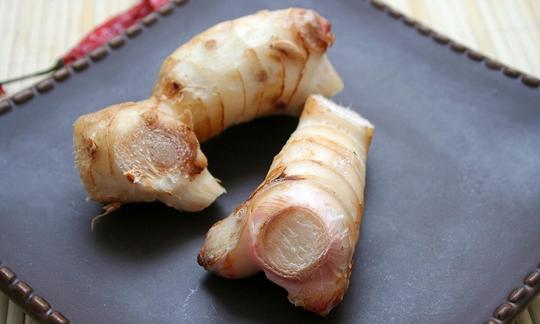

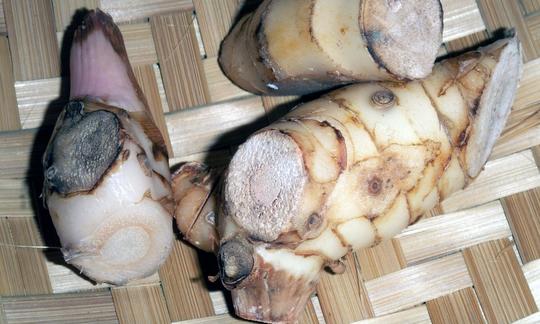

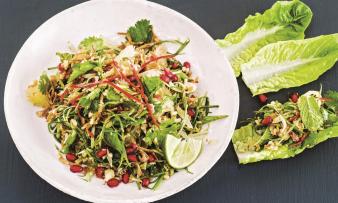
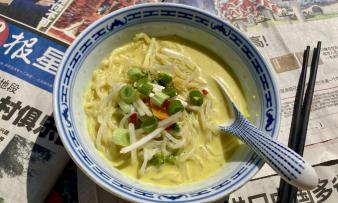
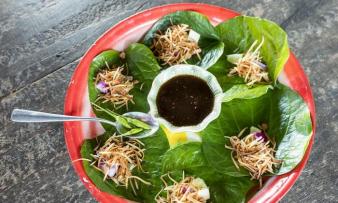


Comments